Posts in Category: Seasonal Pet Care
Cold Weather Cautions for Your Pets

With cooler temperatures approaching, it is important to take precautions to keep your pets safe and warm throughout the winter months.
Prolonged exposure to extreme cool temperatures can lead to frostbite, causing tissue damage to exposed areas, and hypothermia, a life-threatening drop in body temperature. Senior pets, along with very young pets or those with chronic illnesses, are more vulnerable. This becomes important for dogs and cats with arthritis, as cooler temperatures can lead to stiff joints and increased pain in the winter months.
At temperatures above 45°F most dogs are comfortable and safe outside for regular activities like walks and playtime. However, temperatures 45°F or below can cause discomfort in small, thin-coated, senior, immunocompromised, or ill dogs.
Frostbite and hypothermia become risks at temperatures below 32°F, especially in breeds not adapted to cold climates. At temperatures below 0°F, dogs should be allowed outside only for short bathroom breaks. Even hardy breeds can suffer frostbite and hypothermia quickly in these temperatures.
Cats are more vulnerable as temperatures drop below 32°F. Cats should remain indoors as much as possible, as even short exposure can cause frostbite or hypothermia. Frostbite risk areas include ears, tails, and paws. These areas are most susceptible to frostbite because they have less fur and are prone to freezing.
Symptoms of hypothermia include shivering, lifting paws off the ground, whining or attempting to return indoors, lethargy, stiff muscles, slow breathing, and pale or blue gums. This can be life-threatening!
Precautions for Your Dogs
Know your dog’s cold tolerance and limit time outside. Try to keep your dog indoors as much as possible while ensuring that they get enough exercise. Shorten walks in extremely cold weather and keep your dog active indoors by providing enrichment and indoor play.
Avoid shaving your dog’s coat during winter as their natural fur provides insulation. Regular brushing can also help their coat retain warmth. Dry your dog thoroughly after exposure to rain or snow to prevent them from getting cold.
Use warm, durable winter coats and jackets, especially for short-haired or small breed dogs. Booties and paw wax protects paws from ice, snow, and harmful chemicals like salt. Consider protective paw balm to help prevent cracking and irritation from cold surfaces and ice melt. Rock salt and other chemicals used to melt snow and ice can irritate your pet’s paw pads and, if licked off the paws, their mouth. Be sure to wipe all paws with a damp towel before your pet licks them. Dogs are at particular risk of salt poisoning during the winter due to the rock salt used, often from licking their paws after a walk. There are many pet-safe ice melt options available.
Antifreeze has a sweet taste that may attract animals. Choose a pet-safe antifreeze because even small amounts of antifreeze can be lethal. Clean any antifreeze spills immediately and keep it out of reach. Coolants and antifreeze made with propylene glycol are less toxic to pets.
What About Outdoor Cats?
Outdoor cats need extra care as they often roam unsupervised. If possible, bring cats indoors during extreme weather. Subzero temperatures, snowstorms, or icy conditions are too dangerous for outdoor cats, so they should be temporarily housed indoors. If housing indoors is not possible, then providing outdoor shelter is very important. Create a weatherproof, insulated shelter with an entrance just large enough for a cat. Line the shelter with straw, as straw repels moisture and provides better insulation than blankets. Cats often seek warmth under car hoods so be very cautious when starting your car in the morning.
In freezing weather, outdoor cats might struggle to find unfrozen water or sufficient prey, leading to dehydration and malnutrition. There are many ways we can help keep outdoor cats safe this winter. Outdoor cats require extra calories to maintain body heat, so proper nutrition is important. Using heated water bowls and replacing water frequently is important to prevent freezing water. Avoid metal bowls as tongues can stick to frozen surfaces.
By taking these precautions, you and your pet can stay warm and healthy this winter.
By Dr. Angélica Calderón
Precauciones Para Sus Mascotas en Climas Fríos
Con la llegada de las temperaturas frías, es importante tomar todas las precauciones adecuadas para mantener a sus mascotas seguras y abrigadas durante los meses de invierno.
La exposición prolongada a temperaturas extremadamente frías puede provocar congelación, e hipotermia, una caída de la temperatura corporal potencialmente mortal. Las mascotas mayores y las muy jóvenes o aquellas con enfermedades crónicas son más vulnerables. Esto es importante para los perros y gatos con artritis, ya que las temperaturas frías pueden provocar rigidez en las articulaciones y aumento del dolor en los huesos.

A temperaturas superiores a 45 °F, la mayoría de los perros se sienten cómodos y seguros afuera para actividades como paseos y juegos. Sin embargo, las temperaturas de 45 °F o menos pueden causar molestias en perros pequeños, de pelaje fino, mayores, inmunocomprometidos o enfermos. La congelación y la hipotermia se convierten en riesgos a temperaturas inferiores a 32 °F, especialmente en razas no adaptadas a climas fríos. Los gatos son más vulnerables cuando las temperaturas caen por debajo de los 32°F. A temperaturas inferiores a 0 °F, deje que los perros salgan solo para breves descansos para ir al baño. Incluso las razas vulnerables pueden sufrir congelación e hipotermia rápidamente con estas temperaturas. Los gatos deben permanecer en el interior el mayor tiempo posible, ya que incluso una exposición breve puede provocar congelación o hipotermia. Las áreas de riesgo de congelación incluyen orejas, colas y patas. Estas áreas son más susceptibles a la congelación porque tienen menos pelaje y son propensas a congelarse.
Los síntomas de hipotermia incluyen escalofríos, levantar las patas del suelo, gemir o intentar regresar al interior, letargo, rigidez muscular, respiración lenta y encías pálidas o azules. ¡Estos pueden poner en peligro la vida!
Precauciones Para los Perros
Conozca la tolerancia al frío de su perro y limite el tiempo que pasa afuera. Trate de mantener a su perro adentro el mayor tiempo posible, pero asegúrese de que aún haga suficiente ejercicio. Acorte las caminatas en climas extremadamente fríos y mantenga a su perro activo en el interior brindándole enriquecimiento y juego en el interior.
Evite cortar el pelo de su perro muy corto durante el invierno, ya que su pelaje natural le proporciona aislamiento. El cepillado regular también puede ayudar a que su pelaje retenga el calor. Seque bien a su perro después de exponerlo a la lluvia o la nieve para evitar que se enfríe.
Utilice abrigos y chaquetas de invierno cálidos y duraderos, especialmente para perros de pelo corto o de razas pequeñas. Los botines y la cera para patas protegen las patas del hielo, la nieve y productos químicos como la sal. Considere utilizar un bálsamo protector para las patas para ayudar a prevenir la irritación causadas por las superficies frías y el hielo derretido. La sal de roca y otros productos químicos utilizados para derretir la nieve y el hielo pueden irritar las almohadillas de las patas de su mascota. Asegúrese de limpiar todas las patas con una toalla húmeda antes de que su mascota las lama e irrite su boca. Los perros corren un riesgo particular de intoxicación por sal durante el invierno debido a la sal de roca utilizada, casi siempre por lamerse las patas después de un paseo. Hay muchas opciones disponibles para derretir hielo apto para mascotas.
El anticongelante tiene un sabor dulce que puede atraer a los animales. Elija un anticongelante apto para mascotas, ya que el envenenamiento por anticongelante puede ser letal incluso en pequeñas cantidades. Limpie cualquier derrame de anticongelante inmediatamente y manténgalo fuera de su alcance. Los refrigerantes y anticongelantes elaborados con propilenglicol son menos tóxicos para las mascotas.
Y Los Gatos de Afuera?
Los gatos que viven afuera necesitan cuidados especiales, ya que andan sin supervisión. Si es posible, lleve a los gatos al interior durante condiciones climáticas extremas. Las temperaturas bajo cero, las tormentas de nieve o las condiciones heladas son demasiado peligrosas para los gatos que viven afuera y deben de mantenerlos temporalmente adentro. Si no es posible, es muy importante proporcionar refugio afuera. Cree un refugio aislado y resistente a la intemperie con una entrada lo suficientemente grande para un gato. Cubra el refugio con paja, ya que la paja repele la humedad y proporciona un mejor aislamiento que las cobijas. Los gatos suelen buscar calor debajo del capó de los coches, así que hay que tener mucho cuidado.
En climas helados, los gatos de afuera pueden tener dificultades para encontrar agua no congelada o presas suficientes, lo que provoca deshidratación y desnutrición. Hay muchas maneras en que podemos ayudar a mantener seguros a los gatos de afuera.
Los gatos de afuera necesitan calorías adicionales para mantener el calor corporal, por lo que una nutrición adecuada es importante. Es importante utilizar calentadores de agua y reemplazar el agua con frecuencia para evitar que se congele. Evite los tazones de metal ya que la lengua puede pegarse a las superficies congeladas.
Si toma estas precauciones, usted y su mascota podrán mantenerse abrigados y saludables este invierno.
By Dr. Angélica Calderón
How to Protect Your Pets from the Heat This Summer

Summer is a fantastic time to enjoy the outdoors with your pets, but the heat can pose serious risks to their health. High temperatures can lead to dehydration, heat stroke, and even burns from hot surfaces. Here are some essential tips to help you keep your furry friends safe and comfortable during the scorching summer months.
1. Hydration Is Key
Ensure your pets always have access to fresh, cool water. Consider placing multiple water bowls around your home and yard and check them frequently to make sure they are full. Cats usually prefer running water, so consider purchasing a water fountain. For outdoor activities, bring a portable water bottle and bowl so your pet can drink on the go.
2. Avoid the Heat of the Day
Plan your walks and outdoor playtime for early morning or late evening when temperatures are cooler. The midday sun can be intense and dangerous, increasing the risk of heat stroke and burned paw pads from hot pavement.
3. Provide Shade and Ventilation
If your pet spends time outside, make sure they have access to shaded areas. Trees, tarps, or umbrellas can provide relief from direct sunlight. For pets kept indoors, ensure your home is well-ventilated and consider using fans or air conditioning to keep the environment cool.
4. Never Leave Pets in a Parked Car
Even with the windows cracked, temperatures inside a parked car can soar to dangerous levels within minutes. Leaving your pet in a hot car can lead to severe heat stroke or death. If you need to run errands, leave your pet at home in a cool, safe environment.
5. Watch for Signs of Heat Stroke
Heat stroke is a serious condition that requires immediate attention. Symptoms include excessive panting, drooling, lethargy, vomiting, diarrhea, and collapse. If you suspect your pet is suffering from heat stroke, move them to a cool area, offer small amounts of water, and seek immediate veterinary attention.
6. Grooming and Coat Care
Regular grooming can help keep your pet’s coat free of mats and tangles, which can trap heat. However, be cautious with shaving; a pet’s coat provides protection against sunburn and helps regulate their body temperature. Consult your vet or a professional groomer for advice on the best grooming practices for your pet’s breed.
7. Cool Treats and Activities
Help your pet beat the heat with frozen treats and toys. You can make simple ice treats by freezing their favorite snacks in water or broth. Kiddie pools and sprinklers can also provide a fun way for pets to cool off while playing outdoors.
Pro tip: As always, make sure to clean the ears with a veterinary-approved ear cleaner after any water interactions to help prevent ear infections.
8. Mind Hot Surfaces
Pavement, sand, and even artificial grass can become extremely hot and burn your pet’s paws. Before taking your pet for a walk, test the surface with your hand. If it’s too hot for you to touch, it’s too hot for your pet’s paws. Stick to grassy areas or wait until the ground cools down.
9. Regular Health Check-ups
Ensure your pet is up to date with their health check-ups and vaccinations. Some conditions can make pets more vulnerable to heat, and a healthy pet is better equipped to handle the stress of hot weather.
10. Tick and Flea Prevention
Summer is the peak season for ticks and fleas, which can pose serious health risks to your pets. Use veterinarian-recommended tick and flea preventatives regularly. Check your pet’s fur and skin after outdoor activities, especially in wooded or grassy areas. Remove any ticks promptly using tweezers and consult your vet if you notice any signs of flea infestations, such as excessive scratching, red bumps, or hair loss.
By taking these precautions, you can help your pets stay safe, healthy, and happy during the summer heat. Enjoy the sunny season with your furry friends, knowing you’ve done your part to protect them from the dangers of high temperatures.
Stay cool and have a wonderful summer!
— Dr. Ana Valbuena
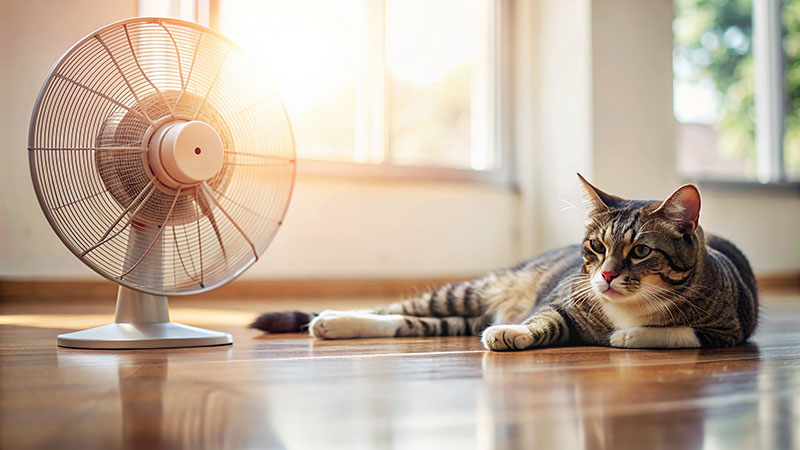
Cómo Proteger a tus Mascotas del Calor este Verano
El verano es un momento fantástico para disfrutar del aire libre con tus mascotas, pero el calor puede representar serios riesgos para su salud. Las altas temperaturas pueden provocar deshidratación, golpes de calor e incluso quemaduras por superficies calientes. Aquí tienes algunos consejos esenciales para ayudar a mantener a tus amigos peludos seguros y cómodos durante los calurosos meses de verano.
1. La Hidratación es Clave
Asegúrate de que tus mascotas siempre tengan acceso a agua fresca y fría. Considera colocar varios tazones de agua alrededor de tu hogar y jardín y revisarlos con frecuencia para asegurarte de que estén llenos. Los gatos suelen preferir el agua corriente, así que considera comprar una fuente de agua. Para las actividades al aire libre, lleva una botella de agua portátil y un tazón para que tu mascota pueda beber en el camino.
2. Evita el Calor del Día
Planifica tus paseos y el tiempo de juego al aire libre para temprano en la mañana o tarde en la noche cuando las temperaturas son más frescas. El sol del mediodía puede ser intenso y peligroso, aumentando el riesgo de golpes de calor y quemaduras en las patas por el pavimento caliente.
3. Proporciona Sombra y Ventilación
Si tu mascota pasa tiempo afuera, asegúrate de que tenga acceso a áreas sombreadas. Los árboles, lonas o sombrillas pueden proporcionar alivio del sol directo. Para las mascotas que se quedan en el interior, asegúrate de que tu hogar esté bien ventilado y considera usar ventiladores o aire acondicionado para mantener el ambiente fresco.
4. Nunca Dejes a las Mascotas en un Auto Estacionado
Incluso con las ventanas entreabiertas, las temperaturas dentro de un coche estacionado pueden elevarse a niveles peligrosos en minutos. Dejar a tu mascota en un coche caliente puede llevar a un golpe de calor severo o la muerte. Si necesitas hacer mandados, deja a tu mascota en casa en un entorno fresco y seguro.
5. Observa los Signos de Golpe de Calor
El golpe de calor es una condición seria que requiere atención inmediata. Los síntomas incluyen jadeo excesivo, salivación, letargo, vómitos, diarrea y colapso. Si sospechas que tu mascota está sufriendo un golpe de calor, muévela a un área fresca, ofrécele pequeñas cantidades de agua y busca atención veterinaria inmediata.
6. Cuidado y Mantenimiento del Pelaje
El aseo regular puede ayudar a mantener el pelaje de tu mascota libre de nudos y enredos, que pueden atrapar el calor. Sin embargo, ten cuidado al rasurar; el pelaje de una mascota proporciona protección contra las quemaduras solares y ayuda a regular su temperatura corporal. Consulta a tu veterinario o a un peluquero profesional para obtener consejos sobre las mejores prácticas de aseo para la raza de tu mascota.
7. Golosinas y Actividades Refrescantes
Ayuda a tu mascota a combatir el calor con golosinas y juguetes congelados. Puedes hacer golosinas sencillas congelando sus snacks favoritos en agua o caldo. Las piscinas para niños y los aspersores también pueden proporcionar una forma divertida para que las mascotas se refresquen mientras juegan al aire libre. Consejo: Como siempre, asegúrate de limpiar las orejas con un limpiador de orejas aprobado por un veterinario después de cualquier interacción con el agua para ayudar a prevenir infecciones de oído.
8. Cuidado con las Superficies Calientes
El pavimento, la arena e incluso el césped artificial pueden volverse extremadamente calientes y quemar las patas de tu mascota. Antes de sacar a tu mascota a pasear, prueba la superficie con tu mano. Si está demasiado caliente para tocarla, está demasiado caliente para las patas de tu mascota. Quédate en áreas con césped o espera hasta que el suelo se enfríe.
9. Prevención de Garrapatas y Pulgas
El verano es la temporada alta para las garrapatas y las pulgas, que pueden representar serios riesgos para la salud de tus mascotas. Usa preventivos contra garrapatas y pulgas recomendados por el veterinario regularmente. Revisa el pelaje y la piel de tu mascota después de actividades al aire libre, especialmente en áreas boscosas o con hierba. Elimina cualquier garrapata rápidamente usando pinzas finas y consulta a tu veterinario si notas cualquier signo de infestación de pulgas, como rascado excesivo, bultos rojos o pérdida de pelo.
10. Revisiones de Salud Regulares
Asegúrate de que tu mascota esté al día con sus chequeos de salud y vacunas. Algunas condiciones pueden hacer que las mascotas sean más vulnerables al calor, y una mascota saludable está mejor equipada para manejar el estrés del clima caluroso.
Tomando estas precauciones, puedes ayudar a tus mascotas a mantenerse seguras, saludables y felices durante el calor del verano. Disfruta de la temporada soleada con tus amigos peludos, sabiendo que has hecho tu parte para protegerlos de los peligros de las altas temperaturas.
¡Mantente fresco y ten un maravilloso verano!
— Dr. Ana Valbuena
Heartworms/Parásitos del Corazón
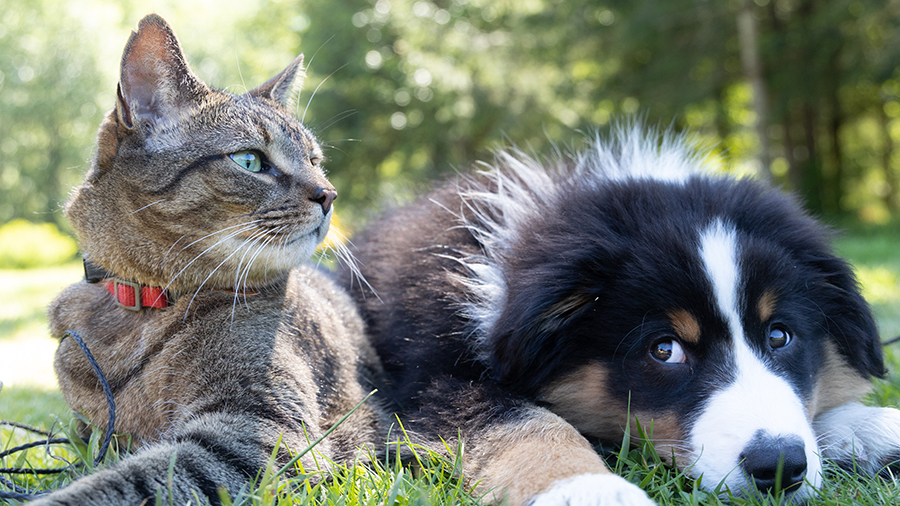
En español
Con el verano acercándose, muchos de nosotros pensamos en el riesgo de las pulgas, garrapatas y parásitos intestinales pero no se olviden de los parásitos del corazón! El parásito del corazón es transmitido por los mosquitos y causa daño irreversible al corazón, las arterias, y los pulmones. No existe cura en los gatos y el tratamiento en los perros es costoso, doloroso, y toma un promedio de un año.
Muchos piensan que sus mascotas no están a riesgo de infección en Illinois como tenemos inviernos largos, pero solo se necesita una mordida de un mosquito que lleva el parásito para ser infectado. Aunque su mascota no salga de la casa, los mosquitos pueden entrar por las ventanas, garajes, puertas, etc.
Es importante realizar que la prevención no previene la exposición y aunque los medicamentos preventivos no matan al parásito adulto, se usan para prevenir la madurez de los gusanos. Si el medicamento preventivo se da sin prueba de diagnóstico y el perro está infectado, no solo se quedará infectado pero también puede causar reacción parecida a un shock. En casos inusuales, también puede resultar en fallecimiento de la mascota.
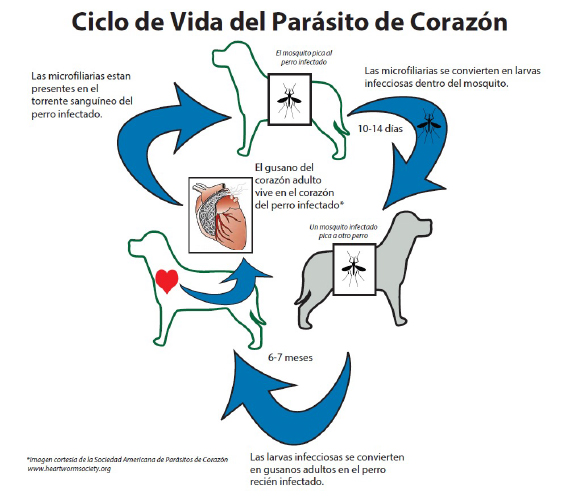
Los gusanos adultos parecen espagueti cocido y pueden llegar a 12 pulgadas. La carga parasitaria puede variar de 1 a 250 gusanos con un promedio en los perros de 15 gusanos! La severidad de los síntomas depende de la carga parasitaria, el nivel de actividad de la mascota, y cuánto tiempo ha estado infectado. Los síntomas más comunes son tos, dificultad para respirar, fatiga, falta de apetito, y pérdida de peso.
El mejor tratamiento es la prevención!
La buena noticia es que existen varios medicamentos preventivos para los perros y gatos! Se necesita una prueba negativa una vez al año (en los perros) para poder recetar el medicamento. Si su mascota no ha tomado la prevención del parásito del corazón de manera constante durante los últimos 12 meses, debería hacer una cita con su veterinario para hacer un análisis de sangre para comprobar un resultado negativo y poder recetar prevención. Hay varias formas de prevención y su veterinario le puede recomendar cual usar basada en su estilo de vida.
In English
With summer approaching, many of us think about the risk of fleas, ticks, and intestinal worms. But don’t forget about heartworms! Heartworms are transmitted by mosquitoes and cause irreversible damage to the heart, arteries, and lungs. There is no cure in cats, and treatment in dogs is expensive, painful, and takes an average of one year.
Many think that their pets are not at risk of infection in Illinois since we have long winters, but it only takes one bite from a mosquito that carries the parasite to be infected. Even if your pet does not leave the house, mosquitoes can enter through windows, garages, doors, etc.
It is important to realize that prevention does not prevent exposure. Although preventative medications do not kill the adult parasite, they are used to prevent the worms from maturing. If the preventative medication is given without a diagnostic test when the dog is already infected, the dog will not only stay infected but the medication can also lead to a shock-like reaction. In rare cases, it can also result in the death of the pet.
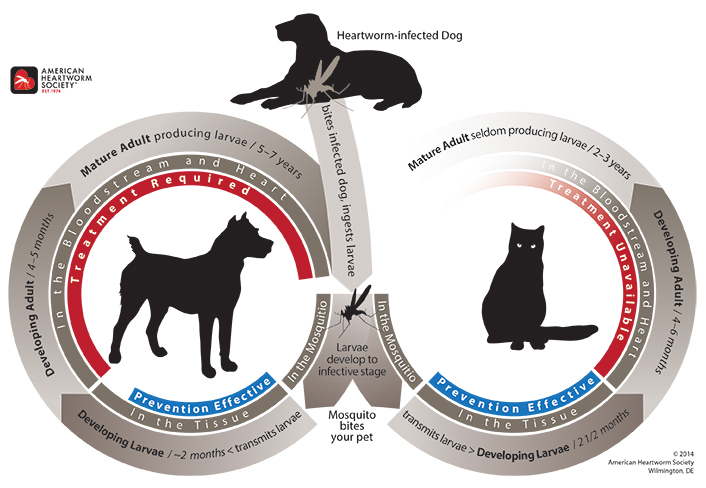
Adult worms look like cooked spaghetti and can grow to 12 inches. The parasite load can range from 1 to 250 worms, with an average of 15 worms in dogs! The severity of the symptoms depends on the parasitic load, the pet’s activity level, and how long they have been infected. The most common symptoms of a heartworm infection are cough, shortness of breath, fatigue, lack of appetite, and weight loss.
The best treatment is prevention!
The good news is that there are several preventative medications for dogs and cats! A negative test is needed once a year (in dogs) before the drug can be prescribed. If your pet has not been on heartworm prevention consistently for the past 12 months, you should make an appointment with your veterinarian for a blood test to confirm a negative result so prevention can be prescribed. There are various forms of prevention, and your vet can recommend which one to use based on your lifestyle.
– Dr. Ana Valbuena
The Itchy Pet
Para leer el blog en español, haga clic aquí

With Chicago’s changing weather, who knows what season we’re currently in right now? And with the season change comes … seasonal allergies, or just allergies in general.
That’s the tricky part that we veterinarians face. We have to investigate and determine what type of allergies your pet is experiencing, and if it is truly allergies versus something else.
As many of you may know, just like people get allergies, so do pets. The signs, however, can be a little different. Many times your pet will show signs of scratching, biting, chewing, and rubbing certain areas of their bodies. You can even see redness, inflammation, fur loss, and, in severe cases, open, infected wounds.
There are many components to allergies, and getting a detailed history from you during the initial vet visit is very important. So although it may seem like an interrogation in the exam room, this is when we are putting all of the puzzle pieces together in our head and thinking of the best diagnostic tests and treatment options for your pet. Each pet is different, and treatment varies on a case-by-case basis.
Flea Allergy
“My cat doesn’t go outside.” “My dog isn’t around other dogs.” “I’ve never seen any fleas on my pet.”

Just because you don’t see them, doesn’t mean they’re not there. Did you know that 1 female flea can lay between 20 and 50 eggs a day?
At times, the only evidence we have to suspect that there are fleas present is flea dirt, which is basically flea feces. Areas that can be affected by fleas include the tail base, neck region, and belly, although fleas can be found anywhere on the body.
A flea allergy is caused by the saliva of the flea itself. All it takes is a few bites to see clinical signs. Fleas can survive at a wide range of temperatures, so it is important to have your pet on flea and tick preventatives year-round to avoid flea allergy dermatitis. Read more about fleas.
Food Allergy
Pets can also have hypersensitivities to certain foods. Although potential allergens can include the food dye, carbohydrates, or preservatives, often it’s the protein source that is the culprit. A food allergy is diagnosed based on a detailed history and, most importantly, a strict food trial.
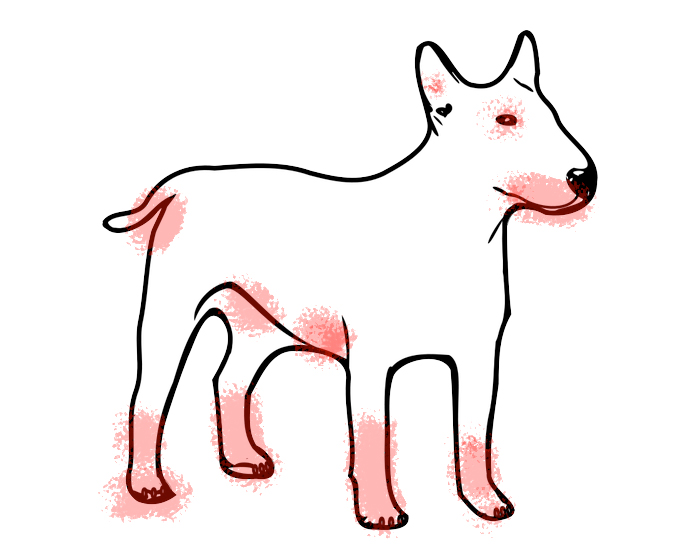
A food trial consists of feeding your pet a hydrolyzed diet or novel protein for a minimum of 8 weeks. This diet is very strict, and it is important that you only feed the novel protein or hydrolyzed diet. You must not feed any additional foods or treats. Keep in mind that many medications and monthly preventatives can be flavored so you must monitor closely what you are feeding and giving your pet. If after the trial period your pet is symptom free, a food challenge is performed. This consists of introducing the previously fed diet and watching for signs of itching or scratching. More details regarding a food trial can be discussed with your veterinarian. Read more about food allergies.
Seasonal vs Environmental Allergies
These can get tricky and hard to diagnose so, as previously mentioned, a thorough history becomes very important. We must investigate if there is any pattern to the clinical signs. Are the signs happening when it is warmer out vs colder? Do the signs show up after walks or after visiting certain areas, like a park or forest preserve? Every detail matters, so it is important to reach out to your veterinarian when your pet starts experiencing signs of excessive itching, scratching, licking, fur thinning, etc.
Treatment for Allergies
Treatment varies on a case-by-case basis. Ultimately, we want to control your pet’s clinical signs but also make your pet comfortable and clear of any secondary infections. Contact your local veterinarian when you start seeing any of the previously mentioned clinical signs.
There are several allergy medications to try. Each pet is different, and sometimes it can take some trial and error to find what works best for your pet, whether that is a single medication or a combination of medications. Allergy medications come in oral, injectable, and topical formats. Your veterinarian will determine which one suits you and your pet’s lifestyle.
Is It Even Allergies?
Although fur loss, fur thinning, over-grooming, and biting can be signs of allergies, these can also be signs of stress, especially in cats. Fur thinning and fur loss can even be signs of endocrine diseases, such as hyperthyroidism or hypothyroidism.
If your pet is experiencing any of the clinical signs mentioned throughout this post, please reach out to your veterinarian so they can determine the best diagnostic test and treatment options for your pet. You and your veterinarian form a team that wants the best for your pet.
– Dr. Angelica Calderon
Comezón de la mascota
Con el clima cambiante de Chicago, quién sabe en qué temporada estamos ahora. Y con el cambio de clima llegan… las alergias. Esa es la parte difícil a la que nos enfrentamos los veterinarios. Tenemos que investigar y determinar qué tipo de alergias está teniendo su mascota y si realmente se trata de alergias o de otra cosa.
Como muchos de ustedes saben, al igual que nosotros podemos tener alergias, las mascotas también pueden hacerlo. Sin embargo, nuestros signos pueden ser un poco diferentes. Muchas veces su mascota puede mostrar signos de rascarse, morderse, y masticar ciertas áreas de su cuerpo. Incluso se puede ver enrojecimiento, inflamación, pérdida de pelo y, en casos graves, heridas abiertas infectadas.
Las alergias tienen muchos componentes y es muy importante obtener un historial detallado durante la visita inicial al veterinario. Entonces, aunque pueda parecer un interrogatorio en la sala de examen, al mismo tiempo estamos juntando todas las piezas del rompecabezas en nuestra cabeza y pensando en las mejores pruebas de diagnóstico y opciones de tratamiento para su mascota, ya que cada mascota es diferente y puede variar según el caso.
Alergia a las pulgas

“Mi gato no sale”, “Mi perro no está con otros perros”, “Nunca he visto pulgas en mi mascota”. Que no los veas no significa que no estén ahí. ¿Sabías que una pulga hembra puede poner aproximadamente de 20 a 50 huevos por día? A veces, la única evidencia que tenemos para sospechar que hay pulgas presentes es la suciedad de pulgas, que es básicamente heces de pulgas. Las áreas que pueden verse afectadas por las pulgas incluyen la base de la cola, la región del cuello y el vientre; aunque se pueden encontrar en cualquier parte del cuerpo. Una alergia a las pulgas es causada por la saliva de la pulga y nada más se necesita algunas picaduras para ver los signos clínicos. Las pulgas pueden sobrevivir en un amplio rango de temperaturas, por lo que es importante que su mascota tome medicamentos preventivos contra pulgas y garrapatas durante todo el año para evitar la dermatitis alérgica por pulgas. Leer más sobre pulgas.
Alergia a la comida

Las mascotas también pueden tener hipersensibilidad a ciertos alimentos. Aunque los alérgenos potenciales pueden incluir colorantes alimentarios, carbohidratos o conservantes; lo más común es la proteína que es la culpable. Una alergia alimentaria se diagnostica en base a un historial detallado y una prueba alimentaria estricta. Una prueba de alimentación consiste en alimentar a tu mascota con una dieta hidrolizada o proteína novedosa durante un mínimo de 8 semanas. Esta dieta es muy estricta y es importante que solo le des la dieta proteica o hidrolizada novedosa. No debe alimentar con alimentos adicionales. Tenga en cuenta que muchos medicamentos y preventivos mensuales pueden tener sabor, por lo que debe controlar de cerca lo que alimenta y le da a su mascota. Si tu mascota está asintomática, se realiza un reto alimentario que consiste en introducir la dieta alimentada previamente y vigilar si presenta signos de picor o rascado. Se pueden discutir más detalles sobre una prueba de alimentos con su veterinario. Leer más sobre alergias alimentarias.
Alergias Estacionales y Ambientales
Estos pueden volverse complicados y difíciles de diagnosticar, por lo que como se mencionó anteriormente, un historial completo y detallado se vuelve muy importante. Debemos investigar si existe algún patrón en los signos clínicos. ¿Están ocurriendo los signos cuando hace más calor que cuando hace más frío? ¿Aparecen los signos después de caminatas o después de visitar ciertas áreas como un parque o una reserva forestal? Cada detalle es importante por lo que es importante comunicarse con su veterinario cuando su mascota comience a enseñar signos de picazón excesiva, rascado, lamido, adelgazamiento del pelaje, etc.
Tratamiento para Alergias
El tratamiento varía según el caso. Queremos controlar los signos clínicos de sus mascotas, pero también hacer que su mascota se sienta cómoda y libre de infecciones secundarias. Esto significa comunicarse con su veterinario local cuando comience a ver cualquiera de los signos clínicos mencionados anteriormente. Hay varios medicamentos para la alergia para probar, sin embargo, cada mascota es diferente y, a veces, puede tomar un poco de prueba y error para finalmente encontrar lo que funciona mejor para su mascota. Qué puede significar un solo medicamento o una combinación de diferentes medicamentos. En cuanto a los medicamentos, hay varias opciones orales para probar, así como opciones inyectables y opciones tópicas. Su veterinario determinará cuál se adapta mejor a usted y al estilo de vida de su mascota.
¿Es incluso alergias?
Aunque la pérdida de pelaje, el adelgazamiento del pelaje, el aseo excesivo y las mordeduras pueden ser signos de alergias; estos también pueden ser signos de estrés, principalmente en gatos. El adelgazamiento y la pérdida de pelo pueden incluso ser signos de varias enfermedades endocrinas como el hipertiroidismo o el hipotiroidismo.
Si su mascota enseña alguno de los signos clínicos mencionados en esta publicación, comuníquese con su veterinario para que pueda determinar las mejores opciones de prueba de diagnóstico y tratamiento para su mascota. Somos un equipo y queremos lo mejor para tu mascota.
– Dr. Angelica Calderon
Salty Paws Make Salty Dogs
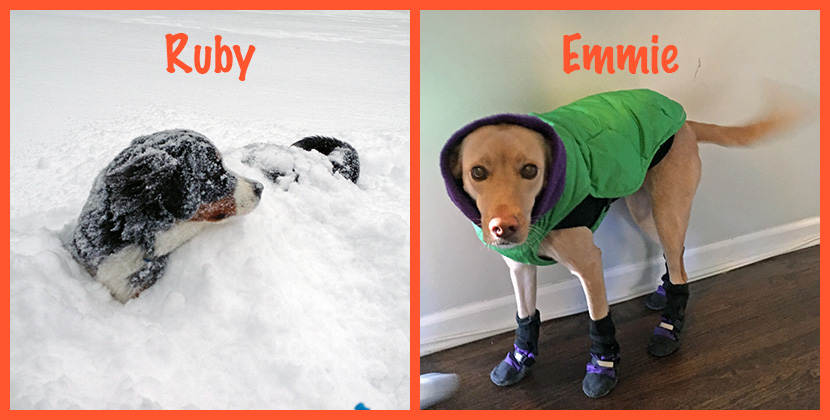
Rock Salt Is the Real Culprit
There comes a point at the end of every year when you can no longer just grab the leash and causally head out for a walk with your dog. (That is, unless you have a Bernese mountain dog like my brother’s dog, Ruby, who would live in the snow if she could.)
Instead, you have to determine how many layers of clothing you and your dog need to go for a walk. I’ve been doing this dance for years with Emmie. Eventually she complies, thankfully. But, just once, I wish she would remember that when we don’t put the booties on and there is salt out, she ends up crying out and her paws hurt.
As cold as our Chicago winters are, there are really only a few days in any calendar year where it is so cold you have to truly worry about a dog’s paws. The real culprit that is causing dogs to lift up their paws and look at you like they’re auditioning for an ASPCA commercial is the rock salt. I’ve definitely had to carry Emmie a few hundred feet through a heavily salted sidewalk stretch when we were caught off guard.
So here are two ways to help protect your pet’s paws, plus what to do if you forget:
Booties
Yes, they are annoying to put on. Yes, they can sometimes fall off. And yes, most dogs don’t like putting them on. But booties are by far the best way to protect your dog’s paws, and when she’s outside she’s much happier.
The key is to find a brand that fits your dog well. Put in the extra effort to measure the size of your dog’s paws for best fit and look for waterproof options, if they are in your budget.
I’m a fan of Muttluks. They have a measuring guide to help ensure the best fit. Remember: Never use a rubber band or any other band that can be constricting to hold up the booties.
Balms
These can be used to try to prevent ice balls from forming between the toes. Balms also help keep small amounts of salt from bothering their paws. The base ingredient for most of these balms is beeswax, but sometimes you can use coconut oil as well.
The most common brand I see is called Musher’s Secret, though a lot of other brands are out there. The upside is that most of these can be licked or ingested with no concerns. The downside is that they tend not to work as well as booties.
Remedies
If you are like me, sometimes you forget. (Or, TBH, are too lazy and depressed about how dark it is at 6:30 in the morning. Even after we go back to standard time, ugh! Which if any of you have a toddler like me, does not mean an extra hour of sleep!)
When you forget and your dog gets salt on her paws, rinse them off with cool water once you’re home. A warm water Epsom salt soak for 5 to 10 minutes will usually fix the problem if her paws are still irritated after everyone has warmed up from the outing. If the paws are still irritated or seem painful after a soak, give us a call.
